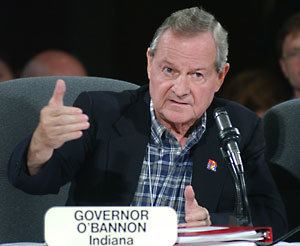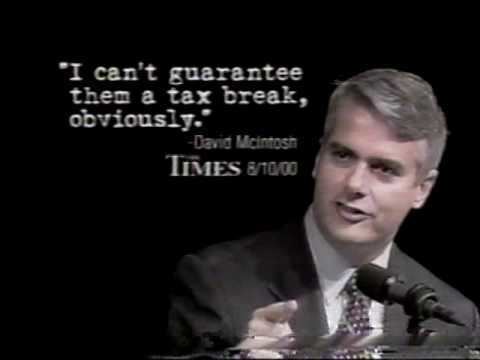Preceded by Robert O'Bannon Spouse Judy O'Bannon (m. 1958) Lieutenant Joe E. Kernan | Succeeded by Joe E. Kernan Succeeded by Joe E. Kernan | |
Education | ||
Frank Lewis O'Bannon (January 30, 1930 – September 13, 2003) was an American politician who served as the 47th Governor of Indiana from 1997 until his death in 2003.
Contents

O'Bannon was a native of Corydon, Indiana. He attended Corydon Central High School and then Indiana University, where he met his wife Judy. In Corydon he served as a practicing attorney and a newspaper publisher for The Corydon Democrat before his entrance into the political arena.

Originally elected to the state senate in 1969, O'Bannon worked his way up in leadership, becoming one of the body's most prominent members. He was briefly a candidate for Governor of Indiana in 1988, however, instead of facing a hotly competitive primary, O'Bannon dropped out of the race and accepted the position of running mate under Evan Bayh. The Bayh/O'Bannon ticket was successful, and O'Bannon served in the role as Lieutenant Governor for 8 years. In this position he served as President of the state senate, and directed the state's agriculture and commerce programs.

In 1996, O'Bannon made a bid for Governor. He was initially considered a heavy underdog, but emerged a narrow victor over Indianapolis Mayor Stephen Goldsmith. He was heavily re-elected in 2000 over Congressman David M. McIntosh. As Governor, O'Bannon was known for advocating for education-related issues and helped create the state's AMBER Alert System. He presided over a period of economic prosperity for the state in the 1990s and served as a term as Chairman of Midwestern Governors Association.
In 2003, O'Bannon suffered a massive stroke in Chicago, Illinois, while attending a trade conference. He died days later and was succeeded by his Lieutenant Governor Joe E. Kernan. Several memorials were dedicated to his memory and his wife still remains active in community and political issues.
Background
O'Bannon was a native of Corydon, Indiana (the first state capital of Indiana), where his family owned the Corydon Democrat, the town's newspaper. He attended Indiana University, where he played one season of basketball for the Hoosiers. At IU, he was president of the Zeta Chapter of the Phi Gamma Delta Fraternity. He earned a B.A. in government in 1952, and a J.D. in 1957 from the Indiana University School of Law – Bloomington.
He also spent two years in the United States Air Force. While at IU, he met his wife, Judith Asmus, and they married in 1958. Following law school, he opened a law office in Corydon, was chairman of the board of the family newspaper publishing firm (a position he held until the time of his death), and was a member of the board of the Corydon Savings and Loan.
Politics before Governor
First elected to the state senate in 1969-70 to a seat occupied by his father, Robert P. O'Bannon from 1950 to 1970, he was the primary sponsor of legislation reintroducing the death penalty. He rose to the rank of Senate Minority Leader among Democrats during his tenure in the legislative body. He served one two-year stint as chair of the Senate Finance Committee following a short-lived Democratic majority. He launched his first campaign for governor in May 1987 from Corydon, Indiana and initially faced off against then-Secretary of State Evan Bayh and Kokomo Mayor Steve Daily. O'Bannon abandoned his own bid for governor in January 1988 and joined forces with Bayh and won election as the 46th Lieutenant Governor of Indiana in November 1988. His candidacy for lieutenant governor matched that of his grandfather, Lew M. O'Bannon, who was the 1924 Democratic nominee for the state's second highest office. As Lieutenant Governor, he presided as President of the State Senate, served as the state's Director of Commerce and Commissioner of Agriculture.
Governor
In 1996 O'Bannon was the Democratic nominee for governor. He overcame an early deficit in the polls against his Republican opponent, Indianapolis mayor Stephen Goldsmith and won in a close race, 52% to 47%. He was re-elected by a larger margin, 57% to 42%, in 2000 against second district Congressman David M. McIntosh.
During the boom years of the 1990s, when Indiana amassed a record $2 billion surplus, O'Bannon was able to cut taxes by $1.5 billion, hire 500 more police officers in the state and win increased funding for schools and extended health insurance for poor families. He also signed landmark legislation creating the AMBER Alert program in Indiana, as well as legislation requiring drivers to slow or change lanes for emergency vehicles stopped along Hoosier roadways.
In the years of 1998 and 1999 O'Bannon served as the Chairman of Midwestern Governors Association. In 1999, O'Bannon created the Public Access Counselor Office by executive order after a statewide collaboration of seven newspapers found great obstacles in obtaining government information in Indiana. In 1999, the Indiana General Assembly established it by statute.
In 2000 he won an easy re-election bid under the theme of Keeping Indiana Moving in the Right Direction. His campaign featured memorable advertisements with O'Bannon reprising his basketball past by shooting a perfect jump shot.
After the 9/11 disaster and subsequent market downturn, Indiana lost 120,000 jobs, tax revenues dropped, and O'Bannon had to cut social services and other services in order to spare education. In 2001 he worked with the state legislature to formulate a major restructuring of the state tax system. His opponents blamed him for various problems arising in the second term, including a slow response by his environmental agency to a big fish kill, and problems at two state centers for the developmentally disabled.
His record, however, was firmly established as an educational leader for the state. He helped lead development of Indiana's first community college system, pushed for early-childhood learning opportunities, development of alternative high schools, and charter schools. His work as chair of the state's landmark Education Roundtable ensured that Indiana was one of only five states whose schools immediately qualified as meeting all standards set by the federal No Child Left Behind act upon enactment.
Death and legacy
O'Bannon suffered a massive stroke on September 8, 2003, while he was in Chicago, Illinois, attending the U.S. Midwest–Japan trade conference. He was taken to Northwestern Memorial Hospital where he remained unconscious.
On September 10, 2003, the Speaker of the Indiana House of Representatives, B. Patrick Bauer (D-South Bend), and the President Pro Tempore of the Indiana Senate, Robert D. Garton (R-Columbus), sent official notice to the Indiana Supreme Court noting that Governor O'Bannon was incapacitated and unable to fulfill the duties of his office. As such, the court approved naming Lieutenant Governor Joe E. Kernan as Acting Governor.
Days later, O'Bannon's condition worsened and based on his living will, his family decided to use no further means of support and care. He died on September 13, 2003, aged 73, leaving behind his wife Judy (Asmus), three children (Polly, Jennifer and Jonathan) and five grandchildren. O'Bannon donated organs (after having signed legislation making organ donation easier in Indiana), including his cornea which helped an Illinois woman regain her sight. He was cremated and buried in the O'Bannon family plot at Cedar Hill Cemetery in his hometown of Corydon, Indiana.
He was succeeded in office by Lieutenant Governor Joe E. Kernan of South Bend, who was sworn into office just hours after O'Bannon's death in an emotional ceremony.
O'Bannon is the subject of the 2006 biography Legacy of a Governor: The Life of Indiana's Frank O'Bannon. The book, written by former O'Bannon staffer Andrew E. Stoner, contains a foreword by his wife, Judy O'Bannon. The book was published by Rooftop Publishing, Inc. of Bloomington, Indiana.
In February 2006, a memorial bust of O'Bannon was placed outside the Indiana Statehouse Senate chambers.
The Frank O'Bannon Public Service Award is given annually by Ivy Tech Community College. The 2007 winner was former State Senator Wayne Townsend of Hartford City, the Democratic candidate for governor in 1984.
In June 2008 a memorial was created in honor of Frank O'Bannon next to the state's original capitol building in his hometown of Corydon. The memorial was built at a cost of $200,000, collected from private donations, and features a life-size statue of O'Bannon sitting on a park bench. Frank O'Bannon Elementary School located in Hammond, Indiana is named after him, as was a section of highway in southern Indiana. The O'Bannon Woods State Park in Harrison County is also named for the O'Bannon family.
Judy O'Bannon resides in her husband's hometown of Corydon, Indiana, and remains active in Corydon Democratic politics and in her husband's newspaper The Corydon Democrat. She endorsed Hillary Clinton in the 2008 presidential race, and often toured with Bill Clinton throughout the state during the 2008 Democratic primary campaign. During the general election she backed Barack Obama for President. She was the vice chair for Jim Schellinger's unsuccessful campaign for governor. She has hosted a statewide public television program, Communities Building Community. In November 2013, she married Donald Willsey.
